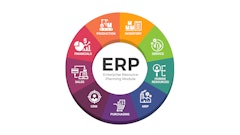
There is a paradigm shift underway in enterprise software that is impacting companies in every industry. Fueled by technical advancements in cloud computing, the Internet of Things (IoT), Big Data and machine learning, there are three trends that are profoundly reshaping how enterprise software is developed, delivered and consumed. Enterprise systems are giving way to business networks, systems of record are taking a back seat to systems of engagement, and rigid commercial off-the-shelf (COTS) software is being replaced by tailored modular solutions.
Shift from Single Enterprise to Network Community
Even though enterprise resource planning (ERP) systems have modules to support a broad range of planning and execution functions, they have one fundamental flaw: They are designed to support single enterprises at a time. This limits an organization’s ability to gain critical insights, as nearly all business functions are conducted between multiple companies and trading partners.
For example, a typical manufacturing company doesn’t make its own raw material, doesn’t move its own products and doesn’t have its own stores. Manufacturers must work with each member of their supply and distribution network to get their products to market.
Out of necessity, companies built individual point-to-point interfaces with their trading partners as an afterthought. Despite electronic data interchange (EDI) standards, these interfaces result in a complex jumble in which every company ends up having to manage their own messy integrations. Furthermore, companies maintain redundant and frequently inconsistent information that needs to be reconciled for each transaction. Since there is no shared visibility into the end customer, the parties are left to second-guess each other. Worse, transactions and executions are sub-optimized because they are all done separately and in isolation.
Today, companies and solution providers realize that the flawed architecture of single enterprise-centric solutions cannot be patched up to support today’s highly dynamic and interconnected business environment. Just as cloud-based social networks create new approaches to how we manage our personal and business contacts, network platforms and communities are changing how business is conducted between the end consumer and all the companies that serve it.
These innovative network platforms are designed from the ground up to represent an interconnected community of business partners that work together to satisfy consumer requirements. Now, a company connects once to the network, and a sophisticated permissions-based framework manages the information each individual organization sees and determines who can interact with whom in what way. Networks allow everyone to be the center of their own universe, yet they provide each member with enterprise services that seamlessly connect into their business partners. Then, there is the beauty of the network effect in which all participants get greater and greater value as more members join.
Before the advent of a multi-party, multi-enterprise business network, it was hard to imagine a zero-information delay across a long value chain. Now, analysts and researchers are only beginning to appreciate the full value of connecting communities and eliminating information delays within a business ecosystem. But, just as social networks are making a colossal impact on social interactions and how individuals stay connected with others, the enterprise systems space is also in for a transformative change for businesses.
Shift to Systems of Engagement and Creating a Single Version of Truth
The rise of cloud business networks is creating a new layer of multi-party, multi-enterprise systems of engagement. They provide a common consumer-driven objective, shared plans, and a transaction, communication and collaboration backbone for end-to-end business processes across all trading partners’ traditional systems of record. According to Forrester, "Systems of engagement that focus on people and not processes are different from the traditional systems of record that log transactions and keep the financial accounting in order. These new systems harness a perfect storm of mobile, social, cloud and Big Data innovation to deliver apps and smart products directly in the context of the daily lives and real-time workflows of customers, partners and employees.”
Companies sink millions of dollars into initiatives to achieve a single version of truth across siloed systems. However, in reality, this is just not possible within the paradigm of enterprise-centric systems of record. Consider the order-to-delivery process as an example. Even if a company spends millions on trying to get to a single instance of ERP, the single version of truth is not possible because a majority of activities in this process are outsourced to trading partners. The ERP becomes disconnected with the process at the enterprise boundary, which requires messy integrations and clunky sequential batch data processes between systems of record. In contrast, systems of engagement operating on networks naturally create and maintain a single version of truth throughout the end-to-end process. This connects the buyer, the seller and any associated service providers across many systems of record, creating a digital supply chain.
Systems of engagement orchestrate execution in lock-step across members by focusing on the only thing that matters to everyone—serving the end customer. Push-oriented business-to-business (B2B) integrations are now replaced by pull-oriented consumer-to-business-to-business (C2B2B) networks.
Systems of engagement are also radically simpler. In the ERP paradigm, separate purchase orders are maintained in the buyer’s system of record and sales orders are maintained in the seller’s system of record that must be reconciled on each activity in the process (i.e., order acknowledgement, shipping, receiving, invoicing, and payment). However, in a system of engagement on a network, the seller’s purchase order and the buyer’s sales orders are simply two views of the same multi-party transaction and no reconciliation is necessary.
A New Level of Intelligence
Modern networks are also highly responsive, as the systems of engagement enable all parties to plan and execute together in real time. As the focus shifts to effective engagement between organizations, companies are leveraging emerging technologies such as Big Data and machine learning to make smart, data-driven predictive decisions. Consequently, systems of engagement are enabling a new level of intelligence.
Autonomous decision-making agents working within systems of engagement are increasingly driving toward self-running processes, such as touchless orders. They use cognitive technologies to continuously update assumptions and decision models so they can anticipate, influence and optimize interactions in real time. For example, when intelligent agents sense changes in consumer buying behavior, they automatically revise forecasts and orchestrate replenishment execution across the network as they occur. Another example is how e-commerce companies are using agents to anticipate potential delays in delivering a consumer’s order, and are taking proactive action using additional intelligent agents as needed to resolve or mitigate the customer service impact.
From Commercial Off-the-Shelf Software to Tailored Modular Applications
Let’s face it, the vanilla, one-size-fits-all design of COTS systems never actually fits anyone as it requires significant enhancements, customizations and extensions. The business model of buying standard enterprise software, modifying it to fit the business, implementing it and then maintaining the system as business needs change is no longer sustainable. Studies show that the cost and effort of modifying and supporting the user actually increase due to the inflexibility of these COTS systems and the cost of related integration. More importantly, an even bigger hidden cost comes from the loss of agility as a business.
In fact, companies no longer want to buy and pay to maintain software anymore either; they want to pay for outcomes. This is where cloud-based networks offer a whole new approach. Networks are shifting the focus from buying products to buying outcomes, and they support a business model that allows every member to focus on delivering value, which frees the provider to focus on delivering the desired outcomes.
Delivered as a service, networks insulate companies from traditional software headaches, such as the need to keep up with upgrades. Today, tailored business solutions are configured by bringing together and extending many different mini applications and services on a network platform. This is similar to consumers who have tailored personalized solutions to meet their unique needs by assembling an appropriate set of apps on their smartphones and devices.
Recommendations: Steps Business Leaders Can Take Now
While it may seem daunting, transforming business systems beyond antiquated ERP is very possible with the right leadership. To ensure success and streamline the process, start by considering the following:
- Step out of the enterprise box and look beyond your four walls to your business community. Ask what needs to change for the entire value network to be more effective.
- Assess where you and your value chain partners are in key metrics of responsiveness, service and cost. Set aspirations on where you want to be. Challenge the status quo; look beyond incremental improvements.
- Choose between a dual platform or replacement strategy, and map out your journey accordingly.
Deciding the Best Approach for Your Journey
If you are locked in and need to preserve your investment in ERP, then a dual-platform strategy that embraces legacy systems is often the best method. Rather than making costly modifications to the ERP system, an overlay of services from the network can orchestrate business processes between functions and companies. This lets ERP to continue to exist within the confines of the organization today, but adds agility and extensibility to partners. Companies can evolve at their pace and minimize risk.
However, if you are an emerging business that is not yet locked in on ERP or if your legacy systems are already unsustainable, then a network as a straight replacement strategy may be appropriate. In this instance, companies start by building out the new platform as an alternative to ERP, which enables them to simplify their business and introduce agility. Regardless of your preferred approach, there is no arguing that new technology is creating a whole new world for today’s businesses.

![Pros To Know 2026 [color]](https://img.sdcexec.com/mindful/acbm/workspaces/default/uploads/2025/08/prostoknow-2026-color.mduFvhpgMk.png?auto=format%2Ccompress&bg=fff&fill-color=fff&fit=fill&h=100&q=70&w=100)







![Pros To Know 2026 [color]](https://img.sdcexec.com/mindful/acbm/workspaces/default/uploads/2025/08/prostoknow-2026-color.mduFvhpgMk.png?ar=16%3A9&auto=format%2Ccompress&bg=fff&fill-color=fff&fit=fill&h=135&q=70&w=240)








